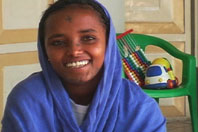Second ChancesHaving a baby can be one of the most joyous events in a woman's life. Yet for the millions of young women in the developing world who develop severe injuries called fistulas from obstructed labor, it's the beginning of a living nightmare, one that can last the rest of their lives. Since 1974, when she and her late husband Reginald established the Addis Ababa Fistula Hospital in Ethiopia, Dr. Catherine Hamlin has given her all to curing fistulas and restoring life to these women, many of whom are just teenagers. In this interview, conducted at the fistula hospital by "A Walk to Beautiful" codirectors Mary Olive Smith and Amy Bucher, Hamlin talks about just how heartbreaking this tragedy can be for poor women—and how miraculous the cure. Note: To learn more about the Addis Ababa Fistula Hospital and the U.S.-based Fistula Foundation, see www.fistulafoundation.org. A most terrible tragedyQ: Just how bad is a fistula for the woman who gets one? Catherine Hamlin: The vaginal fistula from obstructed labor is one of the worst injuries that a woman can ever suffer from. She's been in labor, she's suffered tremendous pain and long, long labor, she's lost her baby—the baby is stillborn in nearly every case. Then she is left with urine and body waste leaking from the vagina. This is a most terrible tragedy for a beautiful young girl. Her life is ruined. Q: What exactly is a fistula? Hamlin: A fistula is really just an opening between internal organs and the outside world. The fistula we're treating is between the bladder or the rectum and the birth passage or the vagina, and it's caused by long, unrelieved obstructed labor, when a baby can't be born in the 12 hours it usually takes. It's due to a small pelvis or a malposition of the baby inside the mother's uterus. It appears all over the world, not only in developing countries. Every time the uterus contracts it pushes the baby's head against the bone of the pelvis in front and the sacrum of the back. [The sacrum is the part of the spinal column connected to the pelvis.] Every time the mother gets a contraction, the blood supply to that area is cut off as it's being pressed on; the blood can't get through. So that lump of tissue being squashed will die, and it just drops out. It might be the size of a penny or a Mother Teresa dollar. Q: How do you treat it? Hamlin: It's a loss of tissue, not a tear. So this means she's lost some of her bladder wall or some of her rectal wall. You can't just sew it up because there will be a lot of strain on the stitches. So you must dissect around. You take the skin of the vagina, which is called mucosa, and you reflect it carefully with scissors, you push it away from the hole as far as it will go and make the entire hole mobile and soft, so that we can bring it together without tension. If you have tension your stitches won't hold, and it will burst open again. [For more on fistula treatment, watch the program or see our list of links and books.] A shattered lifeQ: Here in Ethiopia, these women come from very hard lives, a lot of poverty. Can you describe what life is like for these women and how this tragedy transpires? Hamlin: Most peasant women in the developing world, and in Ethiopia especially, are second-class citizens really. They have to do all the hard work, in the beginning as children in their own homes. Then later on when they're betrothed they will live with their mother-in-law in her house and learn to be a good wife. They have to do the cooking, grounding of the corn, collecting water from the well, carrying sticks from the forest, and general chores of the household. Because of poverty, an Ethiopian girl hasn't had a good diet, and so she's late in developing, which contributes to the number of fistulas we get. A girl in the West at 15 or 16 would have had a normal puberty. But a girl in Ethiopia at 15 or 16 may be very small, because she hasn't had enough nourishment and she has to do hard work. All her energy has gone into work instead of into growth. "She's worn out, she's exhausted—and she wakes up to a worse horror." So she's married to a farmer boy and looking forward to having a baby. She starts her labor with hope in her heart but also with a big degree of fear because she has no prenatal care. No nurse, no doctor has spoken to her about the labor, what's going to happen. Only the village women, or her mother or mother-in-law, tell her what to expect. So she has fear in her heart. She starts labor and she expects to perhaps deliver by the evening or early morning. But the day goes by and she doesn't have the baby. The village women encourage her. The second day goes by and even a third and fourth—up to 10 days I had a woman in labor. By that time the girl is exhausted and dehydrated, and she finally pushes out a dead baby. There's her dead baby lying on the sheepskin rug on the mud bench beside her. Q: And this is only the beginning of her pain. Hamlin: Yes. She slips into a sleep of exhaustion because of her long labor. She's worn out, she's exhausted—and she wakes up to a worse horror. She finds her urine running into the bed; some 20 percent of these girls find their bowel contents running into the bed. She wishes then that she had died with the baby. Her life is shattered, ruined. She can't control any of her body waste. Her husband comes back from the fields in the evening and says, "Why is the house smelling? Why can't you get up and cook my meal for me?" He probably loves her; most of them do love their wives. He just can't understand what has happened, and he can't really accept this girl. Afterward, he may stay with her two or three days or two or three weeks even, but finally he thinks, "Well, she's no use to me now as a wife." And he will say to her—or, often, she will say to him, "Look, I'm no use to you. I'll go back to my mother and father." Q: How should we feel about the husbands who abandon these girls? Hamlin: We shouldn't condemn them. These men are farmer boys; they might be only 18 or 20. They've never seen a medical condition like this, and they have no idea what's the cause of it. They think that perhaps they have been cursed by God or the devil. They've got superstitious ideas that this has happened to them for some punishment. They don't associate it with the days of labor. They're not cruel. Many of them love their wives. I've had one or two come back and say, "Please cure my wife, I want her. I want her to get better." So we can't condemn these young boys. I condemn the older men who have had two or three wives, an older man who is married to a young teenage girl. He should know better. Q: So then she goes home to her parents. Hamlin: She will go home to her own village—maybe it's next door, maybe some distance away. They run out to welcome her, thinking she's coming home with a baby, and they find her in this state. They love her, they put their arms around her, they hug her, they bring her into the house. But not for long, because of the other children in the house, the neighbors coming and going. They can't manage with somebody who is leaking urine and possibly bowel contents. So the mother will say to the father, "What can we do?" And he'll say, "Well, we'll build a little shed outside and put her [there]." They will build her a little hut somewhere in the village, somewhere on a farm plot they've got, and there she will stay till death. This is the fistula's sufferer's tragedy, her tragic life. Psychologically she's terribly disturbed. She's lost all her femininity, all her dignity, all her hope of having another child, all her hope of mixing with her society. "They're crippled when they're carried in, usually on the backs of their fathers." Dr. Ambaye found one after she'd been nine years in a dark hut on a mud bench with a sheepskin. People were giving her food, but she never went out. She was frightened to go out—frightened of being despised by the village women, frightened to go to the well to get water or to the market to buy grain. Imagine her plight: She lives in a dark hut alone. Her life is very sad. Her whole social life has been ruined. Everything that makes her happy has been taken away. Arriving at hopeQ: So how do these women—the lucky ones—end up at your hospital? Hamlin: Well, perhaps one day a girl will come through the village who has had one of our operations here and been cured. She might sit down beside [the afflicted girl] and say, "Look, there's hope for you. If you can raise the money to get to Addis Ababa, you can be cured." And she'll run out and say to her father, "Do you think you could take me to Addis Ababa?" If he's a good father, he may sell a sheep or cow or goat to raise the money. Or, if she has nobody, she will start begging in the village, and this is what many of these girls do. They beg to raise the money for their bus ticket. We had one sitting on the border with Kenya who arrived with a dirty envelope. Inside was a letter from her missionary doctor saying, "Would you please cure this girl's fistula?" The letter was dated six years before. My husband said, "Why did you wait so long?" She said, "I've been sitting at the bus stop for six years trying to get the money." It's $20.00 to get to Addis Ababa. Q: My goodness. Can you accept every woman who does manage to get to the hospital? Hamlin: We have hostels built on the grounds of this hospital compound, which are really just dormitories where women can sleep and be in a bed without walking the street or staying in somebody's house on the floor. We usually are able to accommodate nearly every patient that comes, which is very important. They struggle to get here, saving up every penny, and if we say come back in two weeks, where would they go? They wouldn't be welcome in a hotel even if it's only one dirham a night. They would be thrown out the next day because of their incontinence. Q: What do these young women do while they're waiting for their surgery? Hamlin: This is a good question, because we have lots of women waiting for two or three weeks or even longer. There's another injury that women get in obstructed labor, which causes crippling to the legs because of nerve damage. It's called a "dropped foot." This happens because of pressure by the baby's head on the pelvis, specifically on the nerve roots that go down to the feet. [Back in her village] a woman lies in bed thinking, "If I keep very still, if I curl up and keep my legs together, maybe the urine will dry up." They don't understand there's a hole there. Their hips and knees become contracted, the muscles wasted, and they're crippled when they're carried in, usually on the backs of their fathers. So they might be here for many months before we're able to operate on their vaginal injuries, because they have to be able to walk and they have to be strong before we start the surgery. This [delay] is a wonderful opportunity for us to help them learn to read and write, to sew and knit, and to learn lots of things about hygiene and, of course, about how the fistula was caused. (Like their husbands, they don't know it was due to a long labor.) It is very important that they should have some education while they're waiting. If we did nothing, they would just sit and comb each other's hair and talk and gossip like any teenagers. But we give them schooling as well. Q: I imagine when they arrive and see all these other women just like them, it must be a wonderful feeling for them. Hamlin: Yes, that's a really important point. This is really why we built the [fistula] hospital, because these women are not welcome in a general hospital. They often can't get in because of the tremendous pressure on the hospital for more urgent things. And they're not welcome because they're smelling and they're poor, so they're often turned away by the guard at the gate. So to have a special hospital for them, or least a special ward to which they can be admitted and looked after, is very important. Also for their psychological trauma—they can meet others who have the same condition. "I never get used to the joy these women display when they're going home." I had a middle-aged woman who had been hiding for a few years in a nunnery in the countryside. When she came into the ward, she said, "Wow, the whole world is here!" She was so excited to be with others with the same condition. She had no idea; she thought she was the only one in Ethiopia confronting this. So this is very important, to nurse them together. And they have a social life together. We see them talking. Once they start to gossip with each other, once they find a group that speaks their own language, they feel at home. They feel they're not being ostracized from their society. They're loved and feel welcomed. This is where the healing process starts. On dancing feetQ: You're making me cry… Tell me about the successful operations. Hamlin: We can close the hole in about 93 percent of cases, and many of those [women] will go home perfectly dry. But an unfortunate percentage still leak even though the fistula is closed, because of weak muscles or nerve damage. We do all we can to repair that and make them at least better than they were with various exercises and sometimes more surgery. Q: What do you see in these women's faces when they're cured and are going home? What's it like for them—and for you and your staff? Hamlin: It is so exciting. I never get used to the joy these women display when they're going home. Sometimes they kiss our shoes and say, "We love you next to God." They are the most grateful patients in the world. I had one woman who was 60, and she had been leaking urine for 40 years. It's also a great reward for the doctors and nurses who have been looking after them. Remember, mostly we're looking after a young person, not patching up an old person for a few more years of life. We've got this girl with her whole life ahead of her, and if she's not cured it's going to be a misery and a horror to her forever. So the joy of seeing a young girl normal again and going home in a new dress with a smile on her face and literally on dancing feet is something that really warms our hearts. This is the fascination of fistula surgery—to make a new life for a young girl who's suffered more than any woman should be called on to endure. Nobody should have to go through this. Childbirth should be a joyful occasion—you're bringing a baby into the world. But to them it's become a nightmare. So the reward for our work is enormous and makes everything so worthwhile. It's why I've been here so long and why I hope I can go on a bit longer. Q: How do you prepare the cured ones for returning home, and how are they welcomed when they get there? Hamlin: Well, we don't really know [how they're welcomed], but we understand that they go back and are welcomed home. As soon as they're cured, we give them a new dress and sometimes a new head scarf, and we talk to them about their future. Either I or some of the doctors or nurses will tell each patient what's going to happen when she gets home. We tell her she'll be welcomed home—by her mother and father if she hasn't got a husband. Then we say, "While you are looking so beautiful and everyone is so joyful around you, there will be one young man who will want to marry you. And he will take you to his home." And then we say, "We hope perhaps next year or in two years time you'll get pregnant again and you'll have a baby. But very important and necessary now, you must get to a hospital for the next baby." We give every patient a card with a description of the operation with all the findings, whether they've been completely cured or [still have some] incontinence. We say, "When you feel the baby walking inside your stomach, you start walking towards the hospital." This is too early, of course, but this gives them the idea they must get to a hospital even if they have to walk. We say, "You could get a fistula, another dead baby, even lose your life." Another chanceQ: What options do the girls and women have once they return home? Hamlin: Until we get women educated, there's nothing for these little girls except marriage and having a baby, a husband, and a home. There are very few jobs available for a woman in a rural village, and so her great aim is to have a family and to have a little house to look after. "In Ethiopia, there may be 100,000 fistula sufferers waiting to be repaired." Many doctors that come from the West say, "Why don't you sterilize these girls so it doesn't happen to them again?" But we would never think of doing that to a girl who's perhaps in her teens or early 20s and tell her that she can never have a baby. Until we get something in the place of this, some education and the feeling that she can have another sort of job if she doesn't want to get married or if she wants to wait a few years, we must encourage her to be married and have a baby. Just to give her joy again. Q: Do any come back pregnant to your hospital? Hamlin: Many of them have come back to us pregnant, because they trust us. I had one woman who had six stillborn babies. Six times a dead baby, and with the last one she got a fistula. I said to her when she came in, "I'm going to get you a live baby." When we cleared the fistula, we told her, "Go home and get a new husband. Come back when you are six or seven months pregnant and you can live here and we'll look after you and we'll take you for a cesarean section." We did that, and she got a beautiful live baby. So that was a great success story. She came back to our ward to convalesce, because after a cesarean section they don't stay in [a general] hospital for many days and yet they're not strong enough to make the journey home to the provinces. So they come down here, and we're able to give them baby clothes and shawls for the baby and get them breast-feeding and looking after the baby. And one day when she was lying in bed in one of our wards we had a visit from the queen's daughter from England, Princess Anne. I told her the story, and she started to cry, like you are. This story was so touching to her, to think that [this woman had] been through labor six times without getting a live baby. Imagine somebody having to suffer like that. Sobering numbersQ: How many fistula patients can you accommodate at the hospital, and how many do you cure every year? Hamlin: We have 120 hospital beds, which are for patients and are always full. And we have 20 to 25 hostel beds, which are for those waiting, and they are always full too. We've got five doctors, and we operate Monday, Wednesday, Thursday, and Friday. Of course, they do most the work now, but I like to keep my head in, and I do a few every week. We are able to get through 22 to 30 patients a week. I think it is quite a number. And every year we've been increasing the number of patients cured. I think this year [2006] the number is over 1,400, and we hope by the end of this year it will be even more. Over the years we've done nearly 30,000 cases. Q: That's wonderful, though I realize it's only scratching the surface of this problem. Just how many fistula sufferers are there in Ethiopia, and in the developing world as a whole? Hamlin: In the whole of Ethiopia, there may be 100,000 fistula sufferers waiting to be repaired. We are only doing at the most 2,000 with our centers, so there are many tens of thousands waiting to be repaired in the countryside. Throughout the developing world there must be two to three million fistula sufferers. Q: Why does Ethiopia have so many fistulas? Hamlin: I think it's because Ethiopia is a huge country—as big as France, Spain, and Portugal together—and it's poor so it's not roaded. There are not enough roads to contact women who live in remote villages, and there are escarpments and mountains that women can't traverse. It's a tourist's paradise, but for the woman in obstructed labor it's a terrible situation. Women can't get help quickly. We also haven't got enough hospitals, doctors, or nurses to overcome this problem. Q: How many qualified doctors are there in Ethiopia? Hamlin: There are 145 obstetricians and gynecologists for the whole of Ethiopia. For [a country of] 77 million people, that's just a pathetic figure—145 for the whole country. And most of these are in Addis Ababa, which is absolutely disastrous for the country women. They have nobody. Most of our patients are from the countryside, of course. Q: How much does it cost to cure one woman? Hamlin: Each operation costs about $450 [U.S.]. Some people think it is quite a lot, but the patients pay nothing; it is free. Our patients are reduced to utter poverty, so we are charitable hospital completely. "I feel very drawn, very compassionate towards them. I love them really." Q: What about prevention? Can you prevent fistulas? Hamlin: We have plans to set up a school of midwifery and get girls from the countryside, girls who have reached a certain level of education, perhaps up to the 10th grade. We would take them from the area they will be going back to, where they live, so they can work in the area and be in charge of two or three villages, and they will know every woman in those villages. We will train them as proper midwives, give them courses, and look after them. We will set them up in a nice house, we will pay them a good salary, and we will have a birthing center where they can deliver normal women. Then anyone else who got into obstructed labor will be sent to our centers or to some provincial hospital. In that way we could prevent these injuries. Having faithQ: You and your husband came to Ethiopia in 1959. What made you come? Hamlin: We had been hoping to work in a developing country for a few years, and we saw this advertisement in The Lancet, the British medical journal, that said, "Gynecologist wanted to found a midwifery school in Addis Ababa, Ethiopia." We applied and we got appointed to work in the health community for three years. We soon came across the fistula patients, and they really broke our hearts. We felt tremendous compassion for them, and sadness to see their plight and hear their stories. So we stayed on, and I've been here ever since. My husband would still be here if he was alive. Q: What's your personal relationship to all these girls? Do you think of them as patients? Hamlin: No, I don't think of them as patients. I think of them as individual girls, and I feel very drawn, very compassionate towards them. I love them really. I often think, "If my sister was lying in that state, how would I treat her? What would I do?" I think they're very attractive, because of their need and because they're often beautiful and very appealing and they're helpless. To see them coming through the gates of this hospital in a state of dejection with nothing in this world but faith and hope that we can cure them, and urine-soaked clothes, it touches the hearts of everyone who meets them. And they're very, very grateful and very affectionate. Q: What are your hopes for the growth of this hospital? Hamlin: We have lots of hopes. We have already got three outreach centers. They are attached to the provincial hospital, because we have to work with the local health bureau in the provinces. We need their help—we need their laboratory, for example. These centers are 30- to 40-bed wards, with a big operating theater and all the facilities as well as kitchen, laundry, and other rooms. The centers are doing fantastic work, and we plan two more next year. With five centers, we will be able to do many more patients. This is a great thing for the women of the countryside, because some of them are so poor they can never raise the money to get to Addis Ababa, and we couldn't possibly accommodate everyone anyway. Q: What do you imagine when you are no longer at the hospital? Do you think it will last for the next 100 years? Hamlin: I have to think about the future of this hospital, because I am getting old. I long for the day when I can be sure before I die that the future is secure, that we've got enough funds invested to run the hospital for many years. There will still be fistula patients here in 2020 and 2030. Perhaps by the end of this century we might have eradicated fistula, but, of course, I will never see that. To feel there is money to be able to do this will give me peace of mind. We know that God is behind this work. I want to say that specially, that He has helped us over the years. We believe in prayer, and we believe that He has answered our prayers for many individual patients. With the work in the hospital we've been blessed. Thank you very
much for this interview. We just hope that this film will make a great
difference to the fistula girls of Ethiopia especially. Thank you.
|

Wubete is one of some 30,000 Ethiopian women whom Catherine Hamlin and her staff at the Addis Ababa Fistula Hospital have given new leases on life since the hospital opened in 1974. 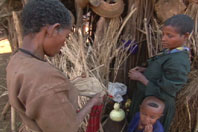
When Ayehu (above at right) developed a fistula during protracted labor and began leaking urine, her parents built her a small hut to live in with her child. 
Women in the developing world often do backbreaking labor from a very young age, leading to the arrested physical development that can cause obstructed labor and fistulas. 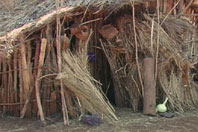
The tiny, mud-floored thatch hut in which Ayehu lived for years in the remote Ethiopian village of Dabola 
For an Ethiopian woman who has no one to help her, getting to the fistula hospital in Addis Ababa can mean a very long and sometimes dangerous walk. 
The fistula hospital, including the hostels where afflicted women await surgery, offers living conditions worlds better than most of these desperately poor patients are used to. 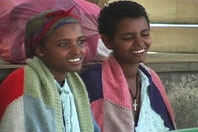
One of the greatest benefits these women get from a stay at the hospital is meeting and talking with others who are suffering from the exact same condition. Here, Wubete (left) and a new friend. 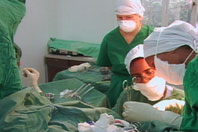
With each successful surgery, the surgeons, nurses, and other staff of the hospital get a huge reward: the profound gratitude of a young woman whose life has been restored to her. 
A patient named Almaz learns from her doctor, Haile Aytenfishu, that her fistula surgery has been successful and she can go home. 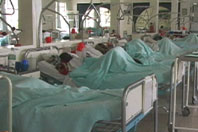
A typical fistula-repair operation and post-operative care at Hamlin's hospital costs just $450 U.S. While that's an inconceivable sum for these women (who are treated for free), it's a small price to pay to give a young girl her life back. To donate to the hospital, go to the Fistula Foundation Web site. 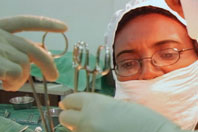
The number of obstetricians and gynecologists in Ethiopia is abysmally low—just one for roughly every 530,000 people. 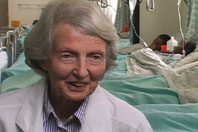
Catherine Hamlin first came to Ethiopia with her husband Reginald in 1959, and she has remained ever since. "It's really been a labor of love for me," she says. |
|
The several interviews from which this interview was assembled were conducted by Mary Olive Smith and Amy Bucher, codirectors of "A Walk to Beautiful," in April 2005 and November 2006, and edited by Peter Tyson, editor in chief of NOVA online. A Walk to Beautiful Home | Send Feedback | Image Credits | Support NOVA |
© | Created March 2008 |
|
|
|

